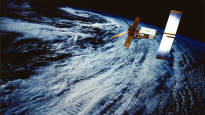The large ERS-2 satellite has fallen down into the Pacific Ocean between Alaska and Hawaii. Relegation is now assured. A round earlier, it passed over Finland very low.
The European Space Agency’s ESA’s two-ton remote sensing satellite ERS-2 was destroyed by falling into the atmosphere in the evening.
ensured by ESA with the help of its partners according to information, the return to the country finally took place at 19:17 Finnish time in the Pacific Ocean near the United States. The previous estimate was slightly earlier, when the satellite would have been over the Norwegian Sea.
Before its destruction, the satellite was already orbiting the Earth very low, where the sparse gas in the upper atmosphere slowed it down with its air resistance. When coming down, the density of the gas increased, and so did the braking force.
Since the satellite’s exact position, rotation, and gas density in different parts of the globe are not exactly known, the ESA air traffic control in Darmstadt, Germany, could only provide estimates of the fall time.
The final, confirmed information about the fall was received at 19:30 Finnish time.
The satellite crossed Finland on its previous round.
The overflight lasted only a few minutes, so the probability that parts of the satellite would have fallen in Finland was extremely small.
A hundred kilos of satellite debris probably survived the fierce heat of entering the atmosphere and fell into the sea.
The two ERS satellites were the forerunners of remote sensing satellites, for which the technology developed is now used in many satellites. Launched into space in 1995, ERS-2 was turned off in 2011 after its orbit had been lowered to avoid generating space debris.
Current satellites are designed in such a way that they are brought down in a controlled manner in the atmosphere to be destroyed after their operation.
The story has been updated after receiving the latest forecast.
